
Rethinking Chronic Care in Digital Health Using Purposeful Game-Design Principles
Rethinking Chronic Care in Digital Health Using Purposeful Game-Design Principles
Shweta Sharma, CEO, SigmaMozak Solutions
Dr Rajshri Mallabadi, Director, SigmaMozak Solutions
Why Digital Health Needs Fresh Engagement Models
Digital health, especially in chronic care, continues to face significant engagement drop-offs. Despite advances in medical-grade sensors, remote monitoring, and artificial intelligence (AI)-driven personalization, most apps still struggle to keep patients active beyond a few weeks.
Retention is low, behavior change is inconsistent, and outcomes often fall short. The problem is not technology, it is experience design.
This paper explores what digital health can learn from an unlikely mentor: the world of video and mobile games. The purpose is not to “gamify” health, but to uncover deep insights about how successful games design for retention, motivation, habit, and emotional connection and how these lessons can be ethically and meaningfully translated to patient-centric health systems.
Methodology
This white paper draws on a cross-disciplinary review of:
- 15+ top-performing digital health apps, including Sidekick Health, Headspace, MySugr, and Mango Health, which were selected for their focus on behavior change, habit formation, and chronic care adherence.
- 10+ mobile platforms and products with strong retention and engagement mechanics, including:
- Game-informed behavioral tools such as Duolingo, Habitica, and SuperBetter, which, while not games in the traditional sense, integrate purposeful game design principles to support learning, habit-building, and emotional resilience.
- Commercial mobile games like Pokémon GO, analyzed for their use of adaptive challenges, feedback loops, and social engagement features that sustain long-term player retention.
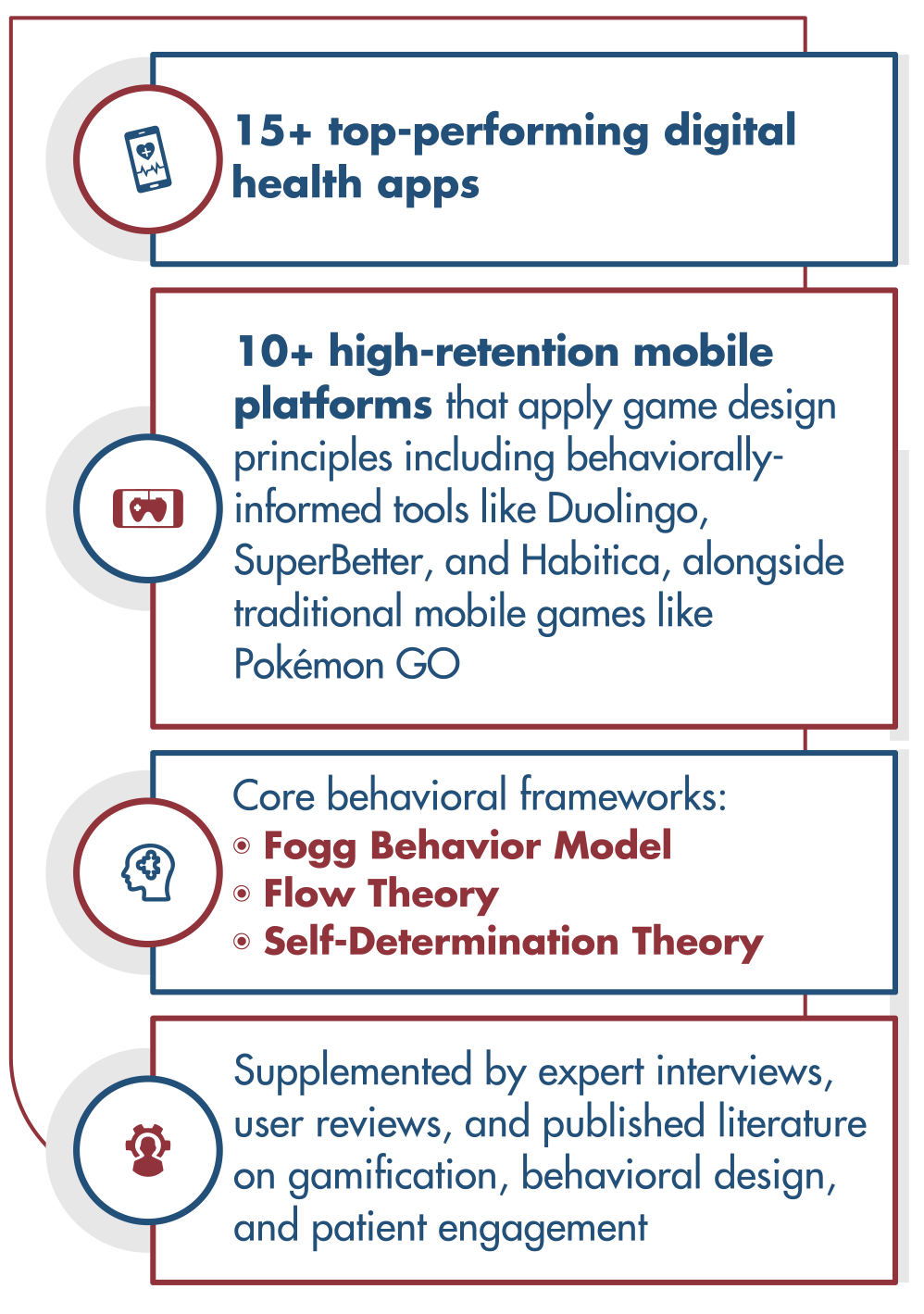
- Core behavioral frameworks, including:
- Fogg Behavior Model (Trigger × Motivation × Ability)
- Flow Theory by Mihály Csíkszentmihályi (balance of challenge and skill)
- Self-Determination Theory by Deci and Ryan (autonomy, competence, relatedness)
- Supplemented by:
- Expert interviews with designers and clinicians
- User reviews across app stores and forums
- Peer-reviewed literature on gamification, behavioral design, and digital health engagement
This research was conducted between March and May 2025 as part of an internal strategic design exploration at SigmaMozak Solutions.
Our Research Question: What Game Design Can Teach Us?
Games succeed not because they are fun, but because they are designed around core human motivations:
- They meet users where they are and guide them forward
- They balance difficulty and skill to maintain focus and momentum
- They normalize failure as part of the journey
- They reward effort and reinforce identity
Behavioral models like the Fogg Behavior Model (trigger × ability × motivation) and Self-Determination Theory (autonomy, competence, relatedness) underpin both successful games and effective health experiences.
We looked at the core principles of game design and analyzed how digital health could incorporate these principles including onboarding, flow state mapping, retention, re-engagement, and integrating feedback loops.
Onboarding: Design the First 5 Minutes Like the First Level of a Game
The onboarding moment is where most health apps fail. Research shows that 77% of users abandon apps within 3 days. Why? Because onboarding often starts with friction—long forms, unfamiliar dashboards, no immediate value. By contrast, the first level of a game does three things exceptionally well:
- Introduces purpose: The player learns why they are here.
- Delivers an early win: Small successes build confidence.
- Teaches as you go: Complexity is revealed, not dumped.
Apps like Flo offer a great example, showing progress potential and asking for only essential info before delivering insights. Headspace uses simple animation and a low-effort intro meditation to convey value.
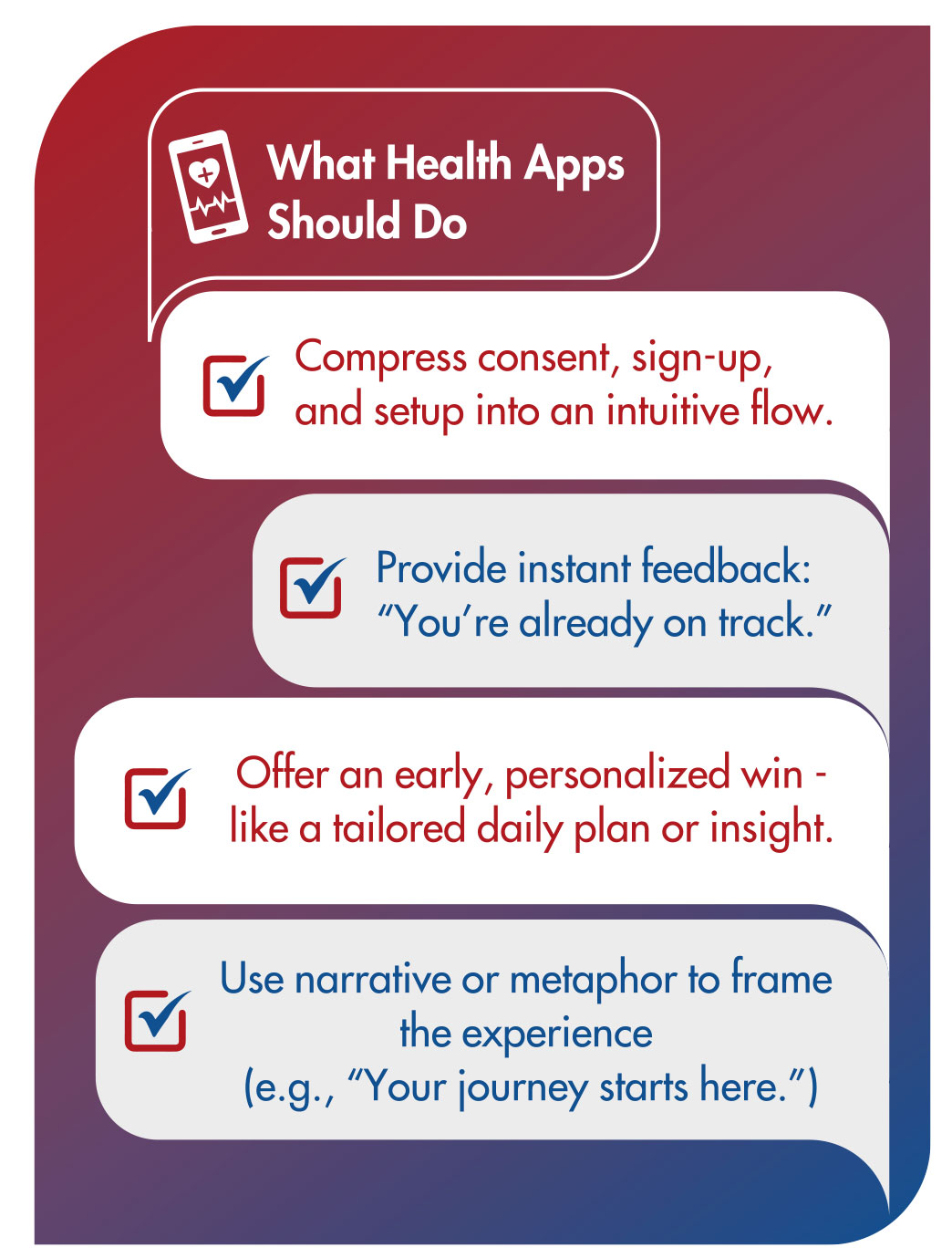
Scaffolding onboarding this way taps into ability (ease), motivation (meaning), and a well-timed prompt – the core of Fogg’s Behavior Model.
Designing for Flow: Keeping Patients in the Engagement Zone
Psychologist Mihaly Csikszentmihalyi’s Flow Theory describes the ideal engagement state: where users are fully immersed, time passes quickly, and motivation is intrinsic. Games maintain flow by continuously adjusting difficulty to match skill level. Health apps often do not.
Problems in Health App Design:
- Daily tasks remain static despite user progress
- New challenges appear without scaffolding
- No clear signal that user is improving
This breaks flow. Users either feel overwhelmed or bored and drop off.
Sidekick Health, a platform for chronic disease management, does this well. Patients complete gamified “missions” and unlock new levels of care routines. Trials show improved adherence and clinical outcomes like lower HbA1c.
Flow depends on feedback too: users must know how they are doing and what is next. A simple prompt like “You’re halfway to this week’s goal” can re-anchor attention and reinforce competence.
Re-Engagement: Designing for Drop-offs and Returns
Health apps are usually designed for ideal behavior – a rare commodity in the real world. The reality is that users will drop off. The goal is not to punish them, but to welcome them back.
In Games:
- Drop-offs are expected
- Players are re-onboarded with recap screens, bonuses, or “You’re back!” sequences
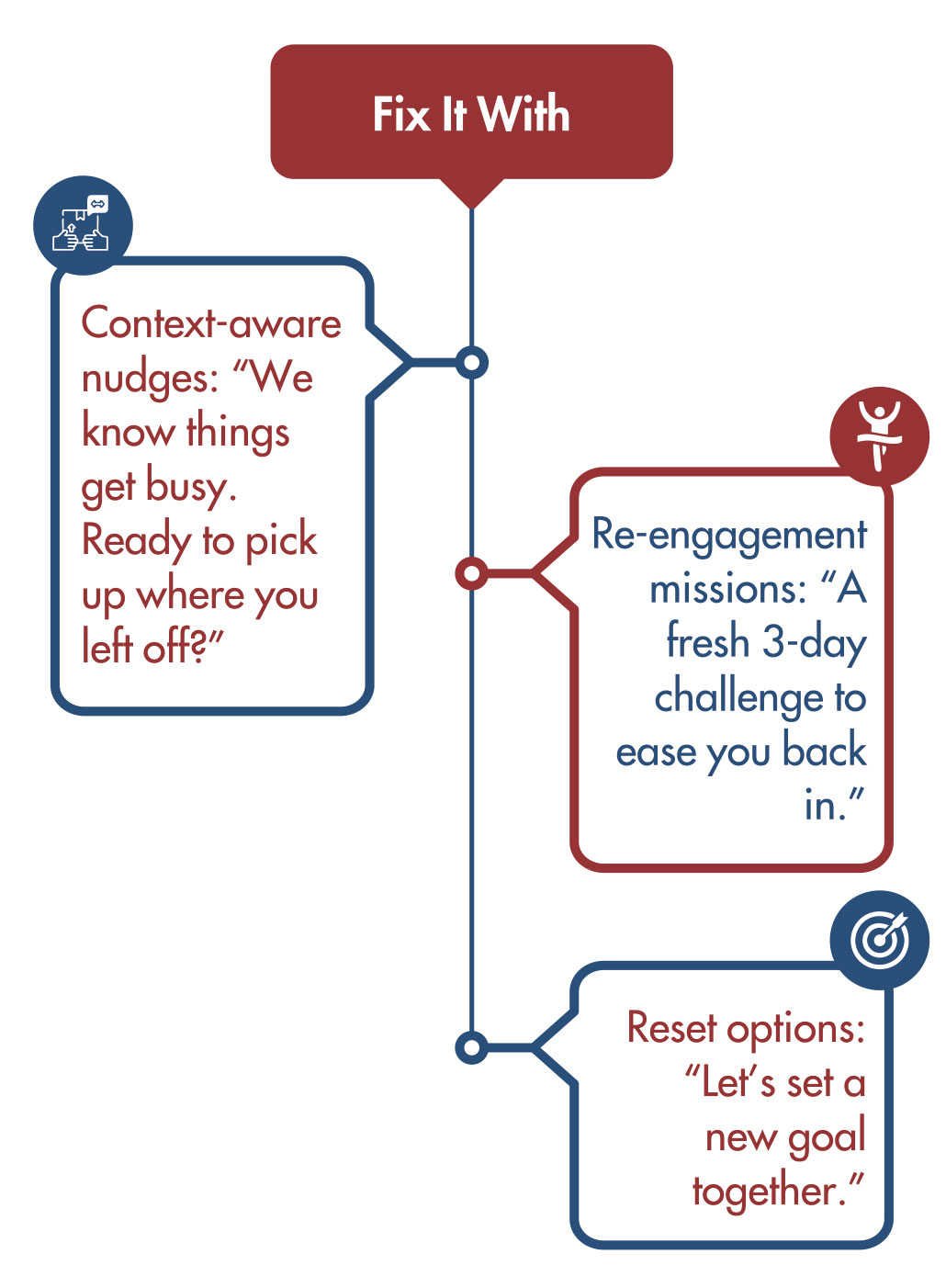
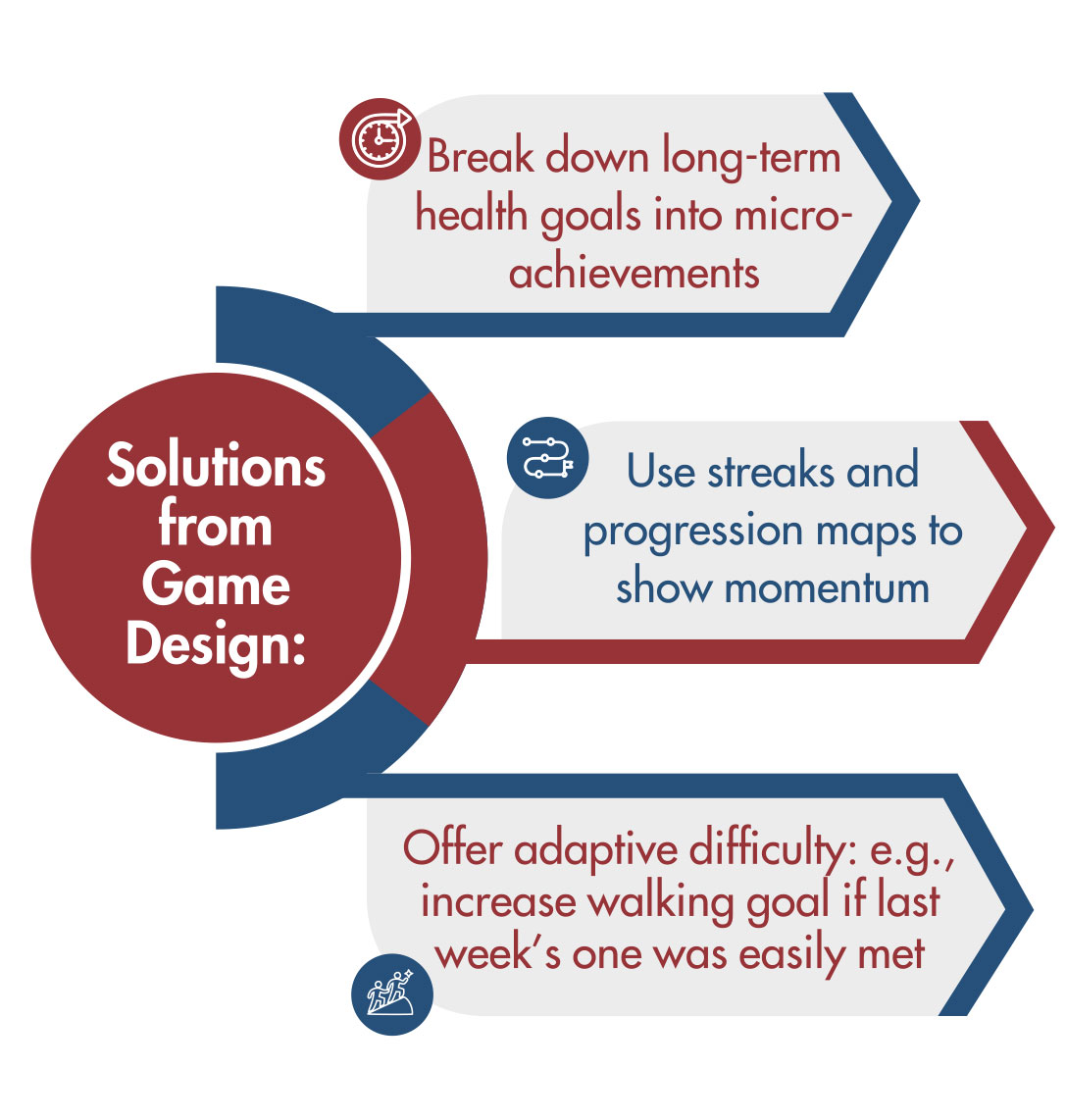
In Health Apps:
- Drop-offs are treated as failure
- No mechanism exists for gentle re-entry
Apps like Mango Health give points for adherence, but also provide encouraging messages when users miss a dose. MySugr allows users to log even partial entries, keeping engagement flexible.
Social features can help too:
- Reminders from care teams or family
- Friendly competition or encouragement (“Team goal: 500,000 steps this week”)
However, designers must tread carefully. Leaderboards can shame or discourage users who lag behind. Re-engagement must feel safe, supportive, and stigma-free.
Emotional Investment and Personalization
Great games are not only engaging – they are personal to boot. Users see themselves in their avatars, their progress, and their growth. Health apps rarely offer this.
To deepen emotional engagement:
- Visualize growth over time (e.g., a blooming tree, a journey map)
- Use narrative framing (“Your resilience scores this week improved!”)
- Let users set or adjust goals (fostering autonomy)
- Let them reflect (“What went well this week?”)
This turns apps from data trackers into companions. It also reinforces identity: “I’m someone who walks daily,” “I’m getting stronger.”
Avoiding the Pitfalls: Health Is Not a Game
This is not about trivializing care. Design must avoid:
- Addiction loops or streak anxiety
- Shaming through competitive features
- Manipulative nudging
Apps like Headspace learned this the hard way – some users became obsessed with their meditation streak, and when they missed a day, they dropped the app. Headspace later added “compassionate” re-engagement: soft resets, encouragement, no streak pressure.
Trust, transparency, and agency are key. Let users opt out of game-like features. Make goals adjustable. Use feedback to inspire, not enforce.
Our Framework for Game-Inspired Health Design
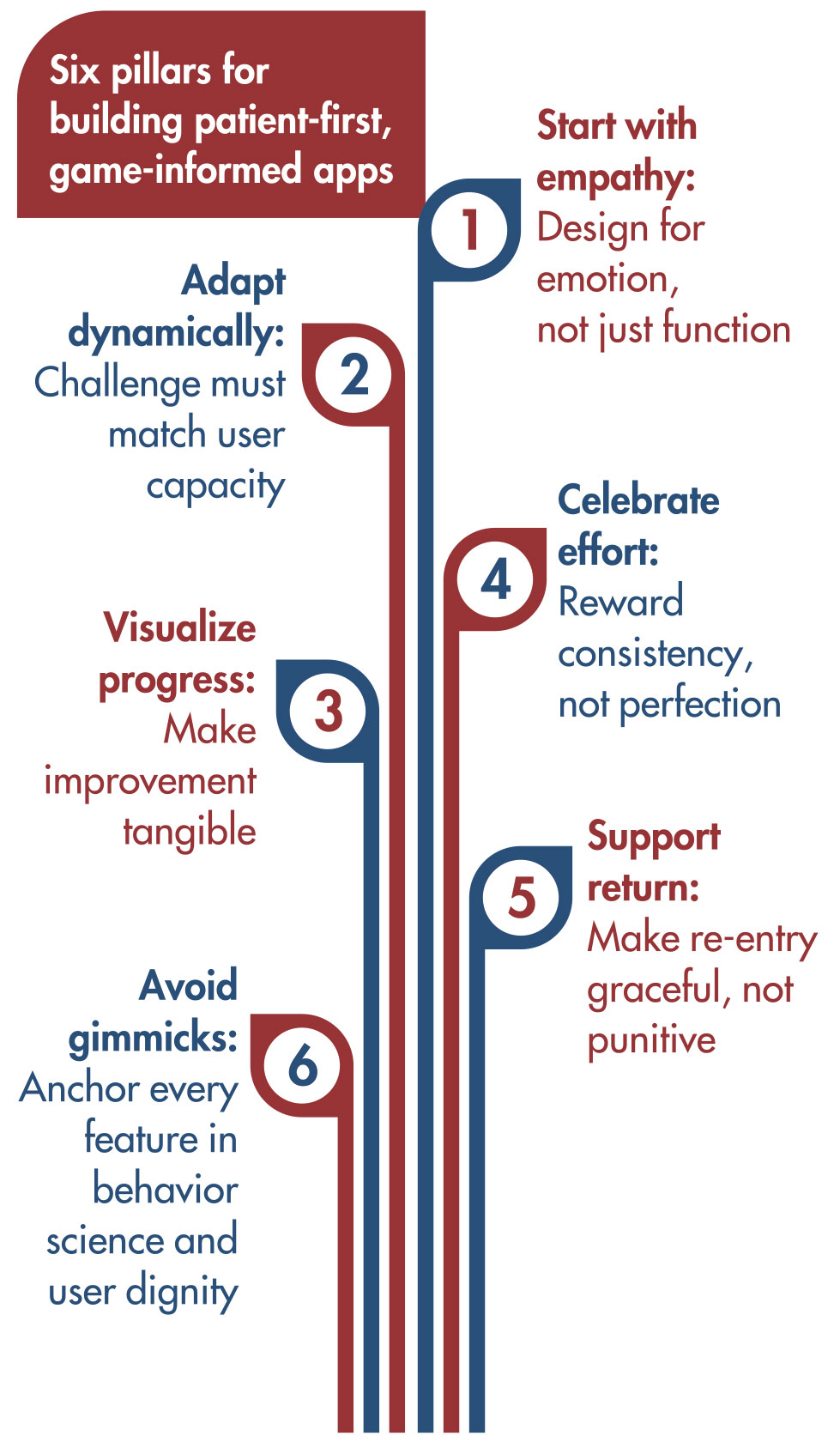
The Path Forward: Purposeful Design, Not Just Engagement
This is not about making health “fun.” It is about making it human. The lessons from games -onboarding, adaptive challenge, re-engagement, and feedback – can help patients build habits that last.
Game-inspired design supports behavior change because it aligns with how people learn, grow, and stay motivated. But in health, the stakes are higher. Every mechanic must serve the user’s health journey, not the app’s engagement metrics.
This way forward is thoughtful, respectful, and behaviorally smart.
Let us design for care, not clicks.
You can download a detailed analysis of each aspect below.
Download WhitePaper
Please enter your email ID to receive the full analysis.
Please enter your email address to receive the download link.


